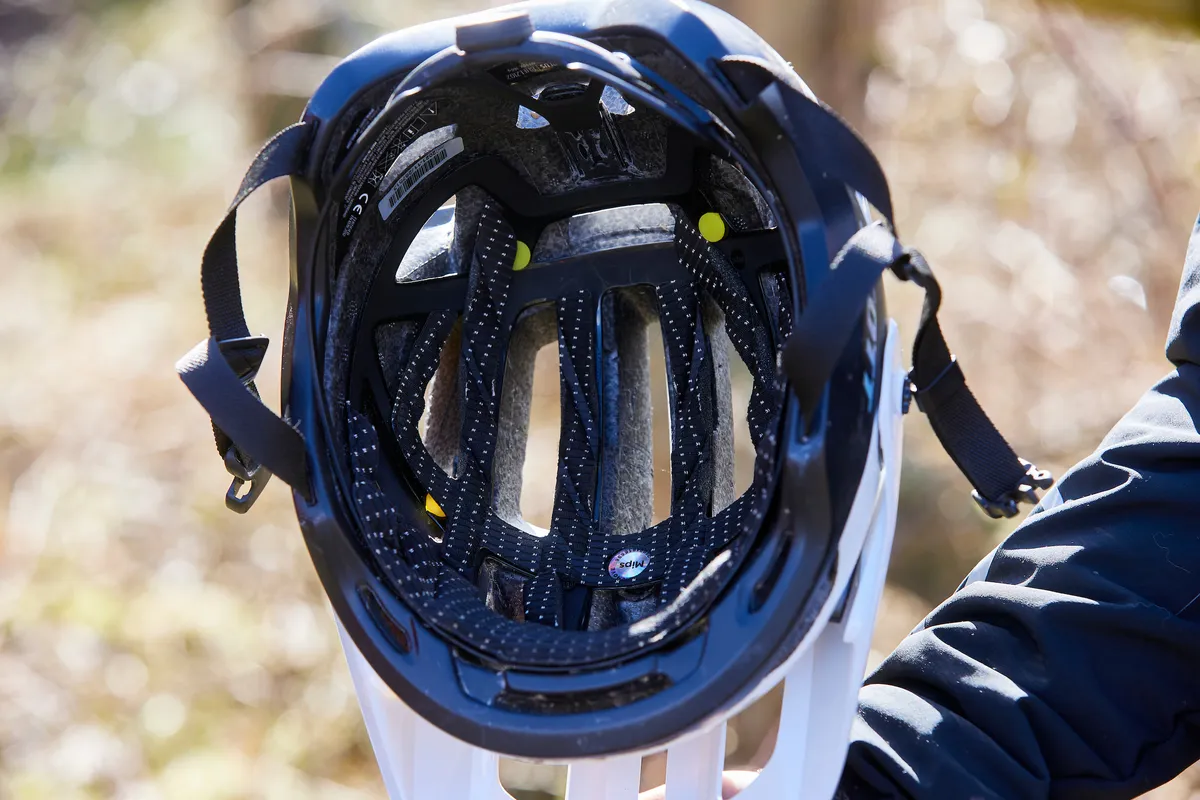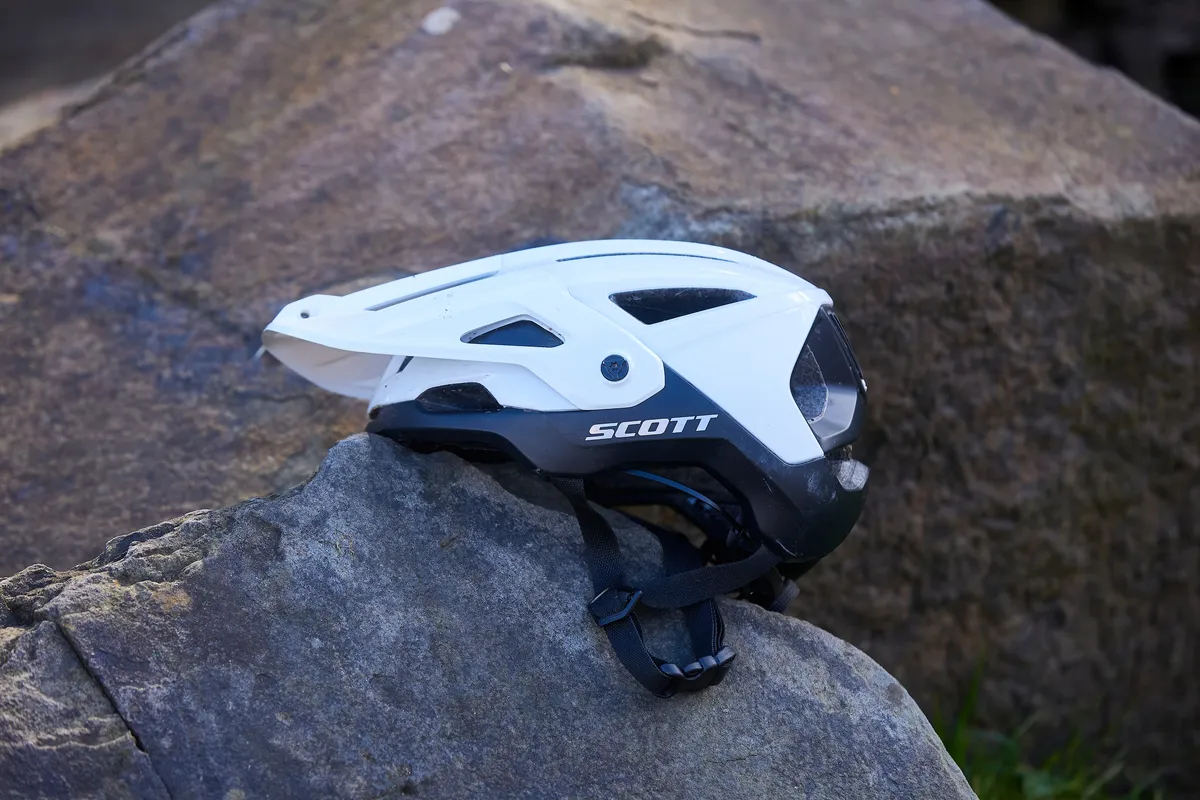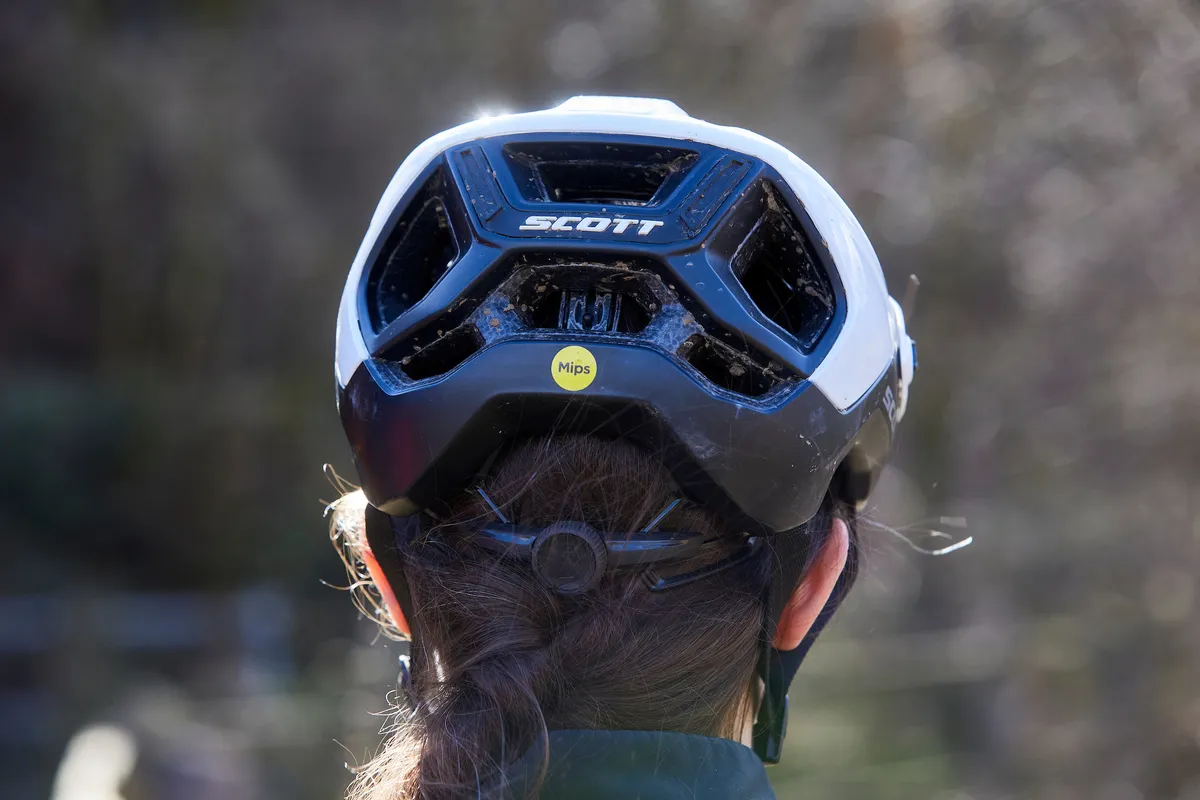The Stego Plus is Scott’s take on an open-face mountain bike helmet. It's intended to be ready to meet the demands of even the most aggressive riders.
It features a polycarbonate shell, EPS and PU foams, and a MIPS liner to deliver increased protection to your head.
The Stego Plus uses a 360-degree fastening system to keep it secure and has some integrated features that help it stand out from the crowd.
Scott Stego Plus helmet details

Scott uses a polycarbonate shell and an in-moulding construction process to mate the helmet's components together, forming a lightweight, yet sturdy design. This process leaves little foam exposed to become damaged by minor bumps and knocks.
The impact protection comes from a single-density EPS foam with added PU (Polyurethane) foam to protect the more sensitive areas of the head. These are fitted just above the temples.
Scott claims this protection covers a wider range of impact speeds, where the EPS deals with high-speed impacts and the PU with low- to mid-speed impacts.
Furthermore, the Stego Plus is fitted with a MIPS liner to help reduce rotational impact forces. The cradle and retention system also form part of the MIPS liner. To help keep the MIPS liner quiet, Scott has added fluffy Velcro between the MIPS and protective foams to eliminate squeaks or creaks.
Scott has used air channels to connect the helmet's 17 vents, with the aim of keeping your head cool. Three of these vents are for channelling air towards your MTB glasses or goggles to help prevent misting.
Scott uses a removable padding that attaches via Velcro to the MIPS liner so it can be washed to keep it fresh.
To help keep the helmet in place, Scott developed the Halo retention system. The rear cradle is part of the liner and a micro-adjust dial fine-tunes the tension. The cradle's height can be adjusted into one of four positions to tailor the fit.

Scott supplies the Stego Plus with two peaks – one standard and one with a GoPro-style mount attachment. They can be swapped out easily by unscrewing the bolts that attach the peak to the helmet.
The peaks can be set in two positions. In the high position, there’s space to store goggles underneath, but there aren’t specific mounts for glasses. The low position is where you set it for riding.
Another small feature is the rubber inserts on the rear of the helmet that provide grip for goggle straps to stop them slipping off.
The Stego Plus scores an impressive 5-star rating from Virginia Tech and comes in at £149.99. There are three sizes available: S (51-55cm), M (55-59cm) and L (59-61cm), with a size-small weighing 373g.
Scott Stego Plus helmet performance

There’s no doubt the Stego Plus wins points for its style and shape. It’s not a bulky helmet, and while rated for impressive protection, if you're looking for a more refined trail lid you'll likely appreciate it. It’s a little weighty, but not so much that I wasn’t happy to wear it all day.
The helmet provides plenty of coverage where needed, over the temples and down the back of the head. However, it doesn’t offer more than the Leatt MTB AllMtn 4.0, or Specialized Ambush 2, which I've also tested.
One of the biggest wins for the Stego Plus is its comfort. It’s up there with the Troy Lee Designs Flowline MIPS. The pads are plush around the forehead, if a little shallower over the top of the head. The cradle covered a large area of the back of my head, minimising pressure.
There were no uncomfortable pressure points when fastening the helmet tightly enough so it didn't slip forwards when riding steep trails and hitting hard compressions.
I found I could ride for extended periods without needing to adjust or loosen the Stego Plus, and it went pretty much unnoticed. Another benefit I found was the peak stayed well out of my vision.
I never had any cradle interference with glasses, so all the pairs I tried stayed in place and comfortable when riding. There isn’t an official place to stash them on the helmet if you get hot, which might be frustrating for some, but you can wedge the arms of your glasses between the helmet and peak.
Scott seems to have favoured planning for riders to use goggles with this lid.

One area where there's room for improvement is ventilation. The air inlet vents are smaller than other mountain bike helmets, such as the Specialized Ambush 2. The Scott isn’t an overly stuffy helmet and there is decent cooling, but it falls behind here.
The GoPro mount on the peak is a smart idea that will please tech-savvy riders. The mounting isn’t perfect though and it takes a little creativity to get a camera in the correct position.
How does the Scott Stego Plus helmet compare to the Bluegrass Rogue Core MIPS?
Both helmets score five stars in Virginia Tech’s safety rating tests and are middling in price and weight for an aggressive open-face trail helmet.
The ventilation is better on the Rogue Core MIPS, so if you run hot, it might be the better choice. Both have features to funnel air into eyewear, however, which helps keep glasses and goggles from misting.
The Scott trumps the Bluegrass for overall comfort, but both are plush and comfortable for long rides. Overall, I prefer the styling and shape of the Scott, but this will likely be a matter of personal preference. On the trail, both helmets are very capable and offer good protection for a decent price.
Scott Stego Plus helmet bottom line
The Scott Stego Plus delivers impressive comfort and safety tech in a smart package.
It’s a fit-and-forget helmet that should provide decent protection when you need it.
However, it’s not the most ventilated mountain bike helmet, and I feel the designers missed a beat making it goggle-friendly instead of compatible with modern riding glasses.
Despite that, its performance is impressive – you'll just have to pay a little more than for other quality helmets.
How we tested
These helmets make up our 2023 trail helmets group test.
We tested nine open-face lids from a range of brands, featuring different tech and takes on performance and comfort to see who came up with the goods.
Product
| Brand | scott |
| Price | 149.99 GBP |
| Weight | 373.0000, GRAM (S) - |
| br_whatWeTested | Scott Stego Plus |
Features
| br_MIPS | yes |
| br_helmetType | mountain_bike_open_face |
| br_smartHelmet | no |
| Features | MIPS, adjustable retention cradle, adjustable peak |
